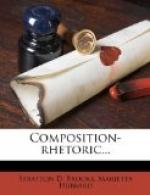—Irving: Legend of Sleepy Hollow.
+Theme LVIII.+—Write a description of one of the following:—
1. My cat. 2. The pony at the farm. 3. The glen. 4. The prairie. 5. The milldam. 6. The motorman. 7. The picture on this page.
[Illustration]
(Consider the effectiveness of your description. Can you improve your choice of words? Have you used comparisons or figures, and if so, do they improve your description? Consider your theme with reference to euphony. Section 16.)
+133. Classes of Objects Frequently Described.+—There is no limit to the things that we may wish to describe, but there are certain general classes of objects that are described more frequently than others. We have greater occasion to describe men or places than we have to describe pictures or trees. A person may be an accurate observer having a large vocabulary applicable to one class of objects, and thus be able to describe objects of that class clearly and effectively; though at the same time, on account of limited experience and small vocabulary, he cannot well describe objects belonging to some other class. The ability to observe accurately the classes of objects named below, and to appreciate descriptions of such objects when made by others, is a desirable acquisition. Every effort should be made to master as many as possible of the words applicable to each class of objects. A slight investigation will show how great is the number of such words with which we are unfamiliar.
1. Descriptions of buildings or portions of buildings.
In most buildings the basement story is heaviest, and each succeeding story increases in lightness; in the Ducal palace this is reversed, making it unique amongst buildings. The outer walls rest upon the pillars of open colonnades, which have a more stumpy appearance than was intended, owing to the raising of the pavement in the piazza. They had, however, no base, but were supported by a continuous stylobate. The chief decorations of the palace were employed upon the capitals of these thirty-six pillars, and it was felt that the peculiar prominence and importance given to its angles rendered it necessary that they should be enriched and softened by sculpture, which is interesting and often most beautiful. The throned figure of Venice above bears a scroll inscribed: Fortis, justa, trono furias, mare sub pede, pono. (Strong and just, I put the furies beneath my throne, and the sea beneath my foot.) One of the corners of the palace joined the irregular buildings connected with St. Mark’s, and is not generally seen. There remained, therefore, only three angles to be decorated. The first main sculpture may be called the “Fig-tree angle,” and its subject is the “Fall of Man.” The second is “the Vine angle,” and represents the “Drunkenness of Noah.” The third sculpture is “the Judgment angle,” and portrays the “Judgment of Solomon.”




